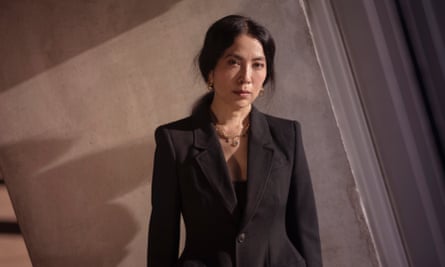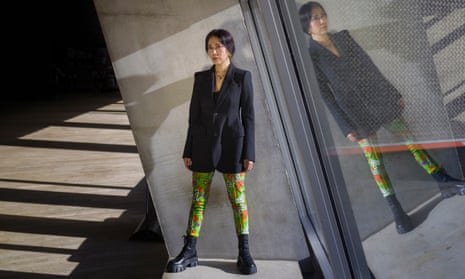Anicka Yi offers me some beetroot crisps. These, along with carrot crisps, are her breakfast, both free of oil and salt. “I can’t eat greens, dairy, sugar, legumes, beans, nuts, seeds, nightshades, spice, alcohol – nothing,” the Korean American conceptual artist explains. “I can only eat grass-fed meat, wild fish, unseasoned all of it, vegetables and a little fruit.”
Why? “I have some auto-immune issues and my doctor put me on a protocol to find out if something in my diet is inflaming them.” Poor you, I say, thinking I should wave away any approaching cheese trolley, as we sit chatting in Tate Modern’s members’ room. The diet has made Yi’s three-week trip from New York to London, to install her latest work in Tate Modern’s Turbine Hall, logistically tricky.
“I knew I couldn’t go to restaurants, so I didn’t know what to do. My doctor said, ‘Get a chef.’” Yi laughs. “Can you imagine what the staff here would think? A new level of prima donna! I need a piano-tuner, an omelette set and a chef.” Instead, Yi cooks in her flat.

The artist believes her diet and her Turbine Hall project are linked, though. The theme of her art is how we don’t listen to our bodies, especially in the sanitised, desensitised, socially mediated, cerebral west. “We are wetware but we like to think of ourselves as hardware,” she says, adding that if we are to use technology to improve our lives, we should use it to enhance – not transcend – our senses. “Your body’s screaming at you, ‘We need attention!’ And you’re like, ‘No thanks.’ How long can you do that for?” She has finally started to listen. “Now my health is the boss of me. It makes all the major decisions in my life. It’s the natural order of things.”
Yi’s work is often olfactory, honouring the sense she thinks humans have neglected in favour of the optical. “I’ve always maintained that when you’re on death row,” she once said, “you should get last scents or last sounds, the same way you get last meals.”
Six years ago, she and French perfumer Barnabé Fillion created a scent called Aliens and Alzheimer’s to explore the idea of forgetting. They infused a book of essays Yi called 6,070,430K of Digital Spit with the fragrance, put it on a spit and rotated it over a flame. Visitors were encouraged to buy the catalogue, which had also been infused with scent, then burn it after reading. It was destructive but at least it made rooms fragrant. “I don’t think of myself as a visual artist at all,” she says. “I don’t really like looking at things. Maybe that’s why I work with olfaction. We give too much weight to that which we can optically observe.”
Foregrounding the smelly is in part Yi’s feminist critique of the patriarchal art world’s visual focus. Our senses, she argues, are conditioned by cultural values. “We associate smells with the feminine. We associate the invisible with the feminine. We associate sight and mastery and knowledge with the masculine.”
What if, Yi wondered in 2015, instead of satisfying the lubricious male gaze through pictures and sculptures of naked women, art explored what she called the “patriarchal fear” of the smell of women. To that end, she asked 100 female friends and colleagues for swab samples. Some swabbed their mouths, others their vaginas. Yi used these samples to grow bacteria in petri dishes, then analysed scent molecules from the collected bacteria, translated the data into a formula and produced a chemical – rather in the way commercial fragrances are made. Then she released the results into the air at an exhibition called You Can Call Me F at the Kitchen gallery in New York. A scent diffuser wafted the aroma through the space where the bacteria samples were alive and growing in petri dishes. “The smell,” wrote one critic, “is innocuous. It’s doubtful the gallery-goer would be conscious of it … were they not told about its peculiarity.”

The following year, at a Guggenheim solo show called Life is Cheap, she suffused the museum entrance with a hybrid scent of ants and Asian American women’s sweat. After entering through a dark tunnel, which Yi said echoed the containment cells the Trump administration was then using to imprison immigrants crossing the Mexican border, visitors encountered plexiglass tiles covered in agar on which more growing bacteria sourced from Asian American women was growing, alongside a colony of ants roaming lighted tunnels. “You’re dealing with a society that is overly obsessed with cleanliness,” Yi explained at the time. “And that’s partially why I do work with bacteria. Especially in the west, we have this morbid fear of pungent aromas, of bacteria. I’m giving a kind of visualisation to people’s anxieties about all the germs and bacteria proliferating all around us.”
Where did Yi’s subversive sense of scents come from? Born in Seoul in 1971, she moved at the age of two with her family to Alabama. Her father was a Protestant and minister, her mother worked for a biomedical corporation. Maybe her art is a response to her parents? Perhaps her dad preached that cleanliness is next to godliness while her mother instilled in Yi and her sisters a fascination with perfumes? Yi laughs. “While it might be titillating for your readers, I think those connections might be a little flimsy. That being said, it doesn’t make them untrue.”
The 50-year-old looks moodily across the Thames. Yi knows London well. She first came here in the early 1990s. “I was running away. I was really lost as a young person and I came here through a relationship. My aspiration was to be a vagabond. I felt like an outcast going against the grain. It’s sad to say but, within one generation, that mode of existence has become extinct. I remember thinking how I envied people who had the commitment to say, ‘I’m going to become an accountant.’ I just couldn’t commit. I know that sounds like the ultimate privilege, but it’s not like I came from generational wealth, or my family was supporting me. It was like hanging off the edge of a cliff for a long, long time.”

Perhaps that vagabondage helped Yi become, albeit belatedly, a distinctive artist, one who never got funnelled through art school but saw visual art with a sceptical outsider’s eye. Returning to New York in the late 1990s, she hooked up with creatives she met at fashion shoots for the Face magazine, and was soon making her first art works from materials other artists disdain. For one installation, she injected live snails with Oxytocin to give them some pep. For another, she made a sculpture of tempura flowers. Yet another involved sculpting with powdered milk, antidepressants, palm tree essence, sea lice, a sandal reduced to dust and a mobile phone signal jammer.
“Anicka Yi is creating a new kind of conceptual art,” wrote the New York Times in 2017. She describes the kind of response she is used to: “It breaks people’s brains, especially young students when I lecture. They’re like, ‘How is she even possible?’ I would not recommend my path because it’s very, very risky.”
If humans had been lead by their noses rather than their eyes, would we be different? Yi nibbles a carrot crisp then says: “Absolutely. Humans are capable of detecting a vast array of odours but we have completely dulled our senses. I think that would give us a very different relationship to our environment. It would impact our microbiome in immeasurable ways. It would probably change our diets. We would be healthier because we’d have more robust biomes. We would communicate in different ways and our tolerance of each other would be higher.
“We are biological beings. We need to smell things, taste things, hear things. The online world can’t capture that. Creating an online reality is not compatible with our physical reality. Look at the things people can get away with online that you can’t face to face – boasting, trolling, stalking.”
In 2019, she explored such themes in two pieces for the Venice Biennale. One, called Biologising the Machine (Tentacular Trouble), involved animatronic moths flying inside giant lanterns made from kelp (despite what Yi says about her lack of visual interest or flair, they were very beautiful to look at). In the other, Biologising Machines (Terra Incognita), she developed a light-based language from bacteria living in muddy panels. “I don’t think we can leave biology behind. I want to foreground a biological approach to cultivating machines and artificial intelligence, rather than it just being a cerebral exercise.”

You sound more like a philosopher than an artist, I say. “I am a philosopher – that’s what I do! I practice philosophy that you can smell, philosophy that you can touch, philosophy that has dimension. It’s not purely abstracted through language. That’s what artists can do – we practice philosophy.”
All this makes her installation at Tate Modern an intriguing prospect. Traditionally, the most popular Turbine Hall commissions are those that have seized the epic space and filled it with the visually clamorous, sometimes bombastic pieces – think Fons Americanus, Kara Walker’s recent giant fountain decorated with slave scenes. It’s an incredibly daunting space. So how does an artist who disdains the visual fill it? “What I like to do is to sculpt the air,” she tells me, keen to keep the precise details under wraps, adding only that the new work will riff on the smells of Tate Modern and London beyond.
“In a way, a place like Tate Modern does lend itself to being infected with a biological agent – that was a very good point of entry for me.” She retooled this idea as the pandemic took hold. “Air connects all of us and yet it is highly risky in the age of Covid. We’re all entangled in this thing called life and we’re all vulnerable to it. The difference between self and other collapses when we realise we’re subject to the same forces. That’s what this project is about. We’re not the impenetrable autonomous entities we would like to think we are. We try to seal borders – against viruses and against humans and against other life forms. But that turns out to be impossible. We need to realise everything is porous.”

Comments (…)
Sign in or create your Guardian account to join the discussion